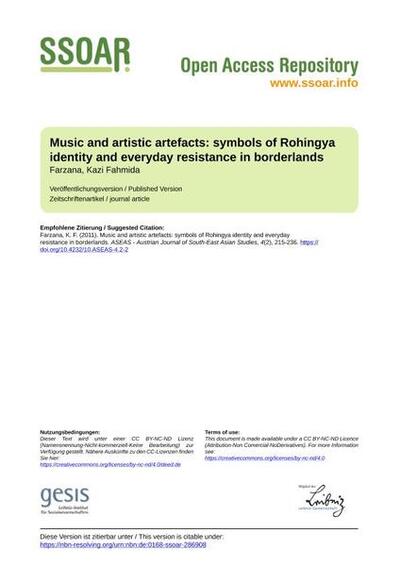Javascript must be enabled to continue!
Music and artistic artefacts: symbols of Rohingya identity and everyday resistance in borderlands
View through Europeana Collections
"This study looks at the creation of music and art by Rohingya refugees in Bangladesh as a symbol of social resistance and identity. Ethnographic research on the Rohingyas' use of music and art suggests that these non-conventional means play an important role in communicating their coherent identity and expressing their resistance to the discrimination and oppression experienced in their country of origin as well as in their exile in Bangladesh. This informal resistance is used to keep their memory alive, to transmit that history through verbal and visual expressions to the new generations, and to communicate information about themselves to outsiders. This article posits that these forms of expression, while suggestive of their identity and everyday resistance, occur mostly in an informal and indirect form, rather than in direct confrontation and protest. These informal means also reflect the Rohingyas' pragmatism and coping strategies for living in the borderlands." (author's abstract)
GESIS - Leibniz Institute for the Social Sciences. Library Cologne
Title: Music and artistic artefacts: symbols of Rohingya identity and everyday resistance in borderlands
Description:
"This study looks at the creation of music and art by Rohingya refugees in Bangladesh as a symbol of social resistance and identity.
Ethnographic research on the Rohingyas' use of music and art suggests that these non-conventional means play an important role in communicating their coherent identity and expressing their resistance to the discrimination and oppression experienced in their country of origin as well as in their exile in Bangladesh.
This informal resistance is used to keep their memory alive, to transmit that history through verbal and visual expressions to the new generations, and to communicate information about themselves to outsiders.
This article posits that these forms of expression, while suggestive of their identity and everyday resistance, occur mostly in an informal and indirect form, rather than in direct confrontation and protest.
These informal means also reflect the Rohingyas' pragmatism and coping strategies for living in the borderlands.
" (author's abstract).
Related Results
Petra Santa Cruz Stevens and the sexual and racial modalities of property relations in the nineteenth-century Arizona–Sonora borderlands
Petra Santa Cruz Stevens and the sexual and racial modalities of property relations in the nineteenth-century Arizona–Sonora borderlands
The 1890s were a period of tremendous social and political upheaval. The intimate nature of boom-bust economies and the end of the Indian wars influenced US–Mexico borderlands soci...
Retuning music teaching: Online music tutorials preferences as predictors of amateur musicians’ music self-efficacy in informal music learning
Retuning music teaching: Online music tutorials preferences as predictors of amateur musicians’ music self-efficacy in informal music learning
Music self-efficacy has been acknowledged as a strong predictor of successful performance among musicians and music students, but is less researched among amateur musicians. The pu...
Pop and world music in Dutch music education: two cases of authentic learning in music teacher education and secondary music education
Pop and world music in Dutch music education: two cases of authentic learning in music teacher education and secondary music education
Popular and world music play an important role in Dutch music education. This article examines two case studies that illustrate authentic music learning environments in which these...
Music and communication in music psychology
Music and communication in music psychology
There is a general consensus that music is both universal and communicative, and musical dialogue is a key element in much music-therapeutic practice. However, the idea that music ...
Tempo in Baroque Music and Dance
Tempo in Baroque Music and Dance
Growing interest in studies on the relationship between music and movement has given rise to many paradigms and theories, including embodied approaches that provide interesting met...
Turn That Racket Down! Physical Anhedonia and Diminished Pleasure From Music
Turn That Racket Down! Physical Anhedonia and Diminished Pleasure From Music
Why do some people not enjoy listening to music as much as others? Two studies explored whether people high in physical anhedonia—an aspect of schizotypy that is associated with re...
Integrating popular music and informal music learning practices: A multiple case study of secondary school music teachers enacting change in music education
Integrating popular music and informal music learning practices: A multiple case study of secondary school music teachers enacting change in music education
The purpose of this multiple case study was to examine the practices and perspectives of four music teachers who integrated popular music and informal music learning practices into...
The gendered carnival of pop
The gendered carnival of pop
One of the ironies of popular music studies is that the music that is the most popular, in terms of contemporary chart success, is rarely discussed by academics writing in the fiel...




